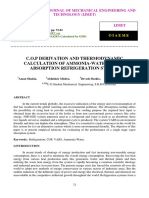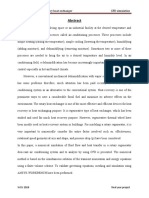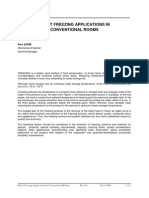Cooling Tower - Design Considerations
Cooling Tower - Design Considerations
Uploaded by
ofelherrera77Copyright:
Available Formats
Cooling Tower - Design Considerations
Cooling Tower - Design Considerations
Uploaded by
ofelherrera77Copyright
Available Formats
Share this document
Did you find this document useful?
Is this content inappropriate?
Copyright:
Available Formats
Cooling Tower - Design Considerations
Cooling Tower - Design Considerations
Uploaded by
ofelherrera77Copyright:
Available Formats
Cooling Towers: Design and Operation Considerations
Cooling towers are a very important part of many chemical plants. They represent a relatively inexpensive and dependable means of removing low grade heat from cooling water.
Figure 1: Closed Loop Cooling Tower System The make-up water source is used to replenish water lost to evaporation. Hot water from heat exchangers is sent to the cooling tower. The water exits the cooling tower and is sent back to the exchangers or to other units for further cooling. Types of Cooling Towers Cooling towers fall into two main sub-divisions: natural draft and mechanical draft. Natural draft designs use very large concrete chimneys to introduce air through the media. Due to the tremendous size of these towers (500 ft high and 400 ft in diameter at the base) they are generally used for water flowrates above 200,000gal/min. Usually these types of towers are only used by utility power stations in the United States. Mechanical draft cooling towers are much more widely used. These towers utilize large fans to force air through circulated water. The water falls downward over fill surfaces which help increase the contact time between the water and the air. This helps maximize heat transfer between the two. Types of Mechanical Draft Towers
Figure 2: Mechanical Draft Counterflow Tower
Figure 3: Mechanical Draft Crossflow Tower
Mechanical draft towers offer control of cooling rates in their fan diameter and speed of operation. These towers often contain several areas (each with their own fan) called cells.
Cooling Tower Theory Heat is transferred from water drops to the surrounding air by the transfer of sensible and latent heat.
Figure 4: Water Drop with Interfacial Film This movement of heat can be modeled with a relation known as the Merkel Equation: (1) where: KaV/L = tower characteristic T1 = hot water temperature (0F or 0C) K = mass transfer coefficient (lb water/h ft2) T2 = cold water temperature (0F or 0C) a = contact area/tower volume T = bulk water temperature (0F or 0C) V = active cooling volume/plan area L = water rate (lb/h ft2) hw = enthalpy of air-water vapor mixture at bulk water temperature (J/kg dry air or Btu/lb dry air) ha = enthalpy of air-water vapor mixture at wet bulb temperature (J/kg dry air or Btu/lb dry air) Thermodynamics also dictate that the heat removed from the water must be equal to the heat absorbed by the surrounding air: (2) (3)
where: L/G = liquid to gas mass flow ratio (lb/lb or kg/kg) T1 = hot water temperature (0F or 0C) T2 = cold water temperature (0F or 0C) h2 = enthalpy of air-water vapor mixture at exhaust wet-bulb temp (same units as above) h1 = enthalpy of air-water vapor mixture at inlet wet-bulb temp (same units as above)
The tower characteristic value can be calculated by solving Equation 1 with the Chebyshev numerical method: (4)
Figure 5: Graphical Representation of Tower Characteristic The following represents a key to Figure 5: C' = Entering air enthalpy at wet-bulb temperature, Twb BC = Initial enthalpy driving force CD = Air operating line with slope L/G DEF = Projecting the exiting air point onto the water operating line and then onto the temperature axis shows the outlet air web-bulb temperature As shown by Equation 1, by finding the area between ABCD in Figure 5, one can find the tower characteristic. An increase in heat load would have the ff. effects on the diagram in Figure 5: 1. Increase in the length of line CD, and a CD line shift to the right 2. Increases in hot and cold water temperatures 3. Increases in range and approach areas The increased heat load causes the hot water temperature to increase considerably faster than does the cold water temperature. Although the area ABCD should remain constant, it actually decreases about 2% for every 10 0F increase in hot water temperature above 100 0F. To account for this decrease, an "adjusted hot water temperature" is used in cooling tower design.
Figure 6: Graph of Adjusted Hot Water Temperatures The area ABCD is expected to change with a change in L/G, this is the very key in the design of cooling towers. Cooling Tower Design Although KaV/L can be calculated, designers typically use charts found in the Cooling Tower Institute Blue Book to estimate KaV/L for given design conditions. It is important to recall three key points in cooling tower design: 1. A change in wet bulb temperature (due to atmospheric conditions) will not change the tower characteristic (KaV/L) 2. A change in the cooling range will not change KaV/L 3. Only a change in the L/G ratio will change KaV/L
Figure 7: A Typical Set of Tower Characteristic Curves The straight line shown in Figure 7 is a plot of L/G vs. KaV/L at a constant airflow. The slope of this line is dependent on the tower packing, but can often be assumed to be -0.60. Figure 7 represents a typical graph supplied by a manufacturer to the purchasing company. From this graph, the plant engineer can see that the proposed tower will be capable of cooling the water to a temperature that is 10 0F above the wet-bulb temperature. This is another key point in cooling tower design. Cooling towers are designed according to the highest geographic wet bulb temperatures. This temperature will dictate the minimum performance available by the tower. As the wet bulb temperature decreases, so will the available cooling water temperature. For example, in the cooling tower represented by Figure 7, if the wet bulb temperature dropped to 75 0F, the cooling water would still be exiting 10 0F above this temperature (85 0F) due to the tower design. Below is the summary of steps in the cooling tower design process in industry. More detail on these steps will be given later. 1. Plant engineer defines the cooling water flowrate, and the inlet and outlet water temperatures for the tower. 2. Manufacturer designs the tower to be able to meet these criteria on a "worst case scenario" (i.e. during the hottest months). The tower characteristic curves and the estimate are given to the plant engineer. 3. Plant engineer reviews bids and makes a selection Design Considerations Once a tower characteristic has been established between the plant engineer and the manufacturer, the manufacturer must design a tower that matches this value. The required tower size will be a function of: 1. Cooling range 2. Approach to wet bulb temperature 3. Mass flowrate of water 4. Web bulb temperature 5. Air velocity through tower or individual tower cell 6. Tower height
In short, nomographs such as the one shown on page 12-15 of Perry's Chemical Engineers' Handbook 6th Ed. utilize the cold water temperature, wet bulb temperature, and hot water temperature to find the water concentration in gal/min ft2. The tower area can then be calculated by dividing the water circulated by the water concentration. General rules are usually used to determine tower height depending on the necessary time of contact: Approach to Wet Bulb (0F) Cooling Range (0F) 15-20 10-15 5-10 25-35 25-35 25-35 Tower Height (ft) 15-20 25-30 35-40
Other design characteristics to consider are fan horsepower, pump horsepower, make-up water source, fogging abatement, and drift eliminators. Operation Considerations 1. Water Make-up Water losses include evaporation, drift (water entrained in discharge vapor), and blowdown (water released to discard solids). Drift losses are estimated to be between 0.1 and 0.2% of water supply. Evaporation Loss = 0.00085 * water flowrate(T1-T2) (5) Blowdown Loss = Evaporation Loss/(cycles-1) (6) where cycles is the ratio of solids in the circulating water to the solids in the make-up water Total Losses = Drift Losses + Evaporation Losses + Blowdown Losses (7) 2. Cold Weather Operation Even during cold weather months, the plant engineer should maintain the design water flowrate and heat load in each cell of the cooling tower. If less water is needed due to temperature changes (i.e. the water is colder), one or more cells should be turned off to maintain the design flow in the other cells. The water in the base of the tower should be maintained between 60 and 70 0F by adjusting air volume if necessary. Usual practice is to run the fans at half speed or turn them off during colder months to maintain this temperature range.
You might also like
- DS418 7th EditionDocument120 pagesDS418 7th EditionClaudia Gh100% (1)
- Heat 4e Chap04 LectureDocument39 pagesHeat 4e Chap04 Lectureehdfhdhdfhdh100% (1)
- Biology Paper 6 NotesDocument6 pagesBiology Paper 6 NotesYasmin Kamel78% (18)
- Refrigeration Cycle SimulationDocument14 pagesRefrigeration Cycle SimulationEduNo ratings yet
- C.O.P Derivation and Thermodynamic Calculation of Ammonia-Water Vapor Absorption Refrigeration System-2 PDFDocument10 pagesC.O.P Derivation and Thermodynamic Calculation of Ammonia-Water Vapor Absorption Refrigeration System-2 PDFErGiteshAroraNo ratings yet
- Final Thesis Rotary RegenerativeDocument58 pagesFinal Thesis Rotary RegenerativeSamuel zerihunNo ratings yet
- Carnot Refrigeration CycleDocument11 pagesCarnot Refrigeration CycleZaimNo ratings yet
- Chiller Comparative Technical ComparativeDocument5 pagesChiller Comparative Technical ComparativeShariq KhawajaNo ratings yet
- Fluidized Bed CombustionDocument32 pagesFluidized Bed CombustionAbdul AhadNo ratings yet
- Economies of Meat Chilling FreezingDocument11 pagesEconomies of Meat Chilling FreezingyemNo ratings yet
- A Review Paper On Performance Evaluation of Desiccant Wheel With Comparative Study of Dehumidification Using Various Desiccant Material Used in Hybrid Air Conditioning.Document8 pagesA Review Paper On Performance Evaluation of Desiccant Wheel With Comparative Study of Dehumidification Using Various Desiccant Material Used in Hybrid Air Conditioning.Bhatu Raman BoraneNo ratings yet
- Modulating Liquid Level Regulators Direct Operated, For Low Pressure SideDocument12 pagesModulating Liquid Level Regulators Direct Operated, For Low Pressure SideLucioRimacNo ratings yet
- DesuperheaterDocument15 pagesDesuperheaterAVI_ROHINI100% (5)
- IceDocument4 pagesIcemuzammilkhatibNo ratings yet
- Biomass BoilerDocument4 pagesBiomass BoilerSuppachai DanpreechakulNo ratings yet
- An Assignment of Principles of Food Preservation and Processing Submitted by - Roll No.Document17 pagesAn Assignment of Principles of Food Preservation and Processing Submitted by - Roll No.Keshav SharmaNo ratings yet
- Cooltech Prsentation - May 2016Document12 pagesCooltech Prsentation - May 2016Cooltech ApplicationsNo ratings yet
- Basic Data SheetDocument15 pagesBasic Data Sheeterkamlakar2234No ratings yet
- Aks4100 (Ficha Tecnica-Nivel de Liquido Danfoss)Document20 pagesAks4100 (Ficha Tecnica-Nivel de Liquido Danfoss)Crypto LegendNo ratings yet
- BE Spec Flash EconomizerDocument4 pagesBE Spec Flash Economizeronkarrathee100% (1)
- Evaporative Condenser Parameter List: Model SVC-800Document3 pagesEvaporative Condenser Parameter List: Model SVC-800nascasNo ratings yet
- Munters Desiccant WheelsDocument8 pagesMunters Desiccant WheelsSerban AlexandraNo ratings yet
- 2nd Part of CalculationDocument26 pages2nd Part of CalculationLohith NatarajNo ratings yet
- Lecture 2-Air Properties and PsychrometricsDocument34 pagesLecture 2-Air Properties and PsychrometricsXiaoyu ZhuNo ratings yet
- Heat of Formation of GypsumDocument2 pagesHeat of Formation of GypsumMohammed Shafi AhmedNo ratings yet
- Carcass Freezing Time Predication by Plate FreezerDocument6 pagesCarcass Freezing Time Predication by Plate FreezerSiti Farah LokmanNo ratings yet
- A Review of Desiccant Dehumidification TechnologyDocument10 pagesA Review of Desiccant Dehumidification TechnologyAlexander VovaNo ratings yet
- Chapter 3 Combustion CalculationDocument34 pagesChapter 3 Combustion CalculationDr p m ajithNo ratings yet
- Carbon Dioxide in Ice Rink RefrigerationDocument65 pagesCarbon Dioxide in Ice Rink RefrigerationSamiYousifNo ratings yet
- Technical Papers: 34th Annual Meeting International Institute of Ammonia RefrigerationDocument40 pagesTechnical Papers: 34th Annual Meeting International Institute of Ammonia Refrigerationrohitkb09No ratings yet
- Carbon Dioxide As A RefrigerantDocument3 pagesCarbon Dioxide As A Refrigerantjimbzthegr8100% (1)
- Improving Dehumidification in HVAC SystemsDocument48 pagesImproving Dehumidification in HVAC Systems2360459No ratings yet
- Blast Freezing Applications inDocument21 pagesBlast Freezing Applications inJoz TeaNo ratings yet
- GPG 283 Designing Energy Eff PlantDocument64 pagesGPG 283 Designing Energy Eff PlantjaysinagojoNo ratings yet
- HVAC Design For Sustainable Lab: by Gregory R. Johnson, P.E., Member ASHRAEDocument11 pagesHVAC Design For Sustainable Lab: by Gregory R. Johnson, P.E., Member ASHRAEAu NguyenNo ratings yet
- Cooling Tower 434Document15 pagesCooling Tower 434arslan MaqboolNo ratings yet
- BAC Website CXVE EN 2021Document30 pagesBAC Website CXVE EN 2021Mahmoud AbubakrNo ratings yet
- Psychrometric ChartDocument1 pagePsychrometric CharttrimNo ratings yet
- (EN) FusionSolar Residential Brochure 230607Document25 pages(EN) FusionSolar Residential Brochure 230607Huy PhanNo ratings yet
- Installation and Maintenance Instructions: Searle Air Cooled Condensers, Dry Coolers and Gas CoolerDocument40 pagesInstallation and Maintenance Instructions: Searle Air Cooled Condensers, Dry Coolers and Gas CoolerYutt WattNo ratings yet
- How To Select The Right Fan or BlowerDocument6 pagesHow To Select The Right Fan or BlowerASHOKNo ratings yet
- JohnDyrebyThesis PDFDocument164 pagesJohnDyrebyThesis PDFaefontalvoNo ratings yet
- Waste Heat Recovery Vinay ShuklaDocument31 pagesWaste Heat Recovery Vinay ShuklaVnyNo ratings yet
- Danfoss Co2 dRZ0ZR102Document16 pagesDanfoss Co2 dRZ0ZR102Denis Alfafrio GotNo ratings yet
- Tutorial SCO2 WilkesDocument99 pagesTutorial SCO2 WilkesAshraf Zoubi100% (1)
- Advantages of Closed Circuit Cooling TowersDocument5 pagesAdvantages of Closed Circuit Cooling TowerskutecoolNo ratings yet
- Chapter 11 PDFDocument8 pagesChapter 11 PDFVisakan ParameswaranNo ratings yet
- Design of Air IDocument5 pagesDesign of Air IInvedeNo ratings yet
- Energy AuditDocument145 pagesEnergy Auditparthasarothi_sikder79No ratings yet
- DST SSCR Rotor PresentationDocument7 pagesDST SSCR Rotor PresentationDanny DurhamNo ratings yet
- Aqua Ammonia PropertiesDocument0 pagesAqua Ammonia Propertieszeeshanahmad111No ratings yet
- Fan SelectionDocument61 pagesFan SelectionJugmohunNo ratings yet
- Chilled BeamsDocument1 pageChilled BeamsrkibNo ratings yet
- Geothermal HVAC - : Exceeding ASHRAE Standards at Lowest Life Cycle CostDocument11 pagesGeothermal HVAC - : Exceeding ASHRAE Standards at Lowest Life Cycle CostKagitha TirumalaNo ratings yet
- Building Heat Loss Building Heat Gain: 1000Xbtu/H 1000Xbtu/H 1000Xbtu/HDocument69 pagesBuilding Heat Loss Building Heat Gain: 1000Xbtu/H 1000Xbtu/H 1000Xbtu/HFarid FarjadNo ratings yet
- Heat Transfer and Pressure Drop Characteristics of Finned Tube Banks in Forced Convection (Comparison of The Heat Transfer Characteristics Between Spiral Fin and Serrated Fin)Document14 pagesHeat Transfer and Pressure Drop Characteristics of Finned Tube Banks in Forced Convection (Comparison of The Heat Transfer Characteristics Between Spiral Fin and Serrated Fin)nadir adel100% (1)
- Hydrocarbons As Refrigerants in Small Heat Pump and RefrigerationDocument12 pagesHydrocarbons As Refrigerants in Small Heat Pump and RefrigerationGiovanniCuocoNo ratings yet
- Cooling Towers Design and Operation ConsiderationsDocument6 pagesCooling Towers Design and Operation ConsiderationsvanmurthyNo ratings yet
- Cooling Towers - Downloaded SkillsDocument22 pagesCooling Towers - Downloaded SkillsVuthpalachaitanya KrishnaNo ratings yet
- Cooling Towers Design and Operation ConsiderationsDocument8 pagesCooling Towers Design and Operation ConsiderationsThieuhuyen Ky100% (2)
- Cooling Towers Design and Operation ConsiderationsDocument10 pagesCooling Towers Design and Operation ConsiderationsLiu YangtzeNo ratings yet
- Cooling Tower Water CalculationsDocument11 pagesCooling Tower Water CalculationsShesadri ChakrabartyNo ratings yet
- General Types of Cooling Tower IllustrationsDocument10 pagesGeneral Types of Cooling Tower IllustrationsanisalyaaNo ratings yet
- What To Do in Chem 205 Lab ReportDocument5 pagesWhat To Do in Chem 205 Lab ReportJonique MajorNo ratings yet
- Design and Fabrication of Thermoelectric CoolerDocument12 pagesDesign and Fabrication of Thermoelectric CoolerwalkerNo ratings yet
- 2010 CM Engineering Manual Pefy-Nmsu-Nmau-NmhuDocument60 pages2010 CM Engineering Manual Pefy-Nmsu-Nmau-NmhuEli Montano VegaNo ratings yet
- HVAC TrainingDocument29 pagesHVAC TrainingSamiullah QureshiNo ratings yet
- Hydrolysis of Acetic Anhydride - Non-Adiabatic Calorimetric Determination of Kinetics and Heat ExchangeDocument6 pagesHydrolysis of Acetic Anhydride - Non-Adiabatic Calorimetric Determination of Kinetics and Heat ExchangeRF ZDavNo ratings yet
- Chapter 7 (Additional Notes) Thermodynamics Review (Power Plant Technology by M Wakil)Document29 pagesChapter 7 (Additional Notes) Thermodynamics Review (Power Plant Technology by M Wakil)Aries SattiNo ratings yet
- Science10 Q4 Mod2 v2Document36 pagesScience10 Q4 Mod2 v2Lerr Real Relle0% (1)
- WL110e V1.1 DuplexDocument100 pagesWL110e V1.1 DuplexHansraj Rahul100% (1)
- Resistors Module 01Document10 pagesResistors Module 01VinodKumarTummalurNo ratings yet
- Transformer Testing - Type Test and Routine Test of TransformerDocument15 pagesTransformer Testing - Type Test and Routine Test of TransformerPrabhakar Ramachandran100% (1)
- Feedback Chap 2 HWDocument13 pagesFeedback Chap 2 HWAudreyWalangareDimalibotNo ratings yet
- The Cooling Process in Gas Quenching: N. LiorDocument8 pagesThe Cooling Process in Gas Quenching: N. LiorananthakumarNo ratings yet
- Trane OAUDocument24 pagesTrane OAUEdNo ratings yet
- Research Paper FinalDocument31 pagesResearch Paper FinalJoe WhitingNo ratings yet
- Domekt R 450 V en PDFDocument1 pageDomekt R 450 V en PDFSima Catalin-IonutNo ratings yet
- Physics - Practical Record Writing - Class XI-2024Document35 pagesPhysics - Practical Record Writing - Class XI-2024Soha TamkeenNo ratings yet
- IEC61508 GuideDocument11 pagesIEC61508 Guidesrbehera1987No ratings yet
- Physics Notes Class 11 CHAPTER 13 KINETIC THEORYDocument6 pagesPhysics Notes Class 11 CHAPTER 13 KINETIC THEORYRitu SharmaNo ratings yet
- Multisplit InverterDocument8 pagesMultisplit Invertermaria jimenez100% (1)
- Relos Lab Rep 3 Me139l-2 E02Document10 pagesRelos Lab Rep 3 Me139l-2 E02Jj JmNo ratings yet
- Physics Vol 1 Master The NCERTDocument450 pagesPhysics Vol 1 Master The NCERTARYAN RANADIVE67% (3)
- Tecumseh 2003Document18 pagesTecumseh 2003willcarl obandoNo ratings yet
- Bypass Vav Terminal UnitDocument3 pagesBypass Vav Terminal Unitfarshan296015No ratings yet
- 1.2. Conversion Factors: Table 1-6Document45 pages1.2. Conversion Factors: Table 1-6Isabel Benitez100% (1)
- A.C DuctsDocument15 pagesA.C DuctsMustafam98No ratings yet
- Specified Data Proposed Data: Schedule & PerformanceDocument2 pagesSpecified Data Proposed Data: Schedule & PerformanceMurugan RaghuNo ratings yet
- 2013 Jaunich Raw Mat and Appl Low Temperature Properties of Rubber SealsDocument6 pages2013 Jaunich Raw Mat and Appl Low Temperature Properties of Rubber SealslienhartviktorNo ratings yet

























































































